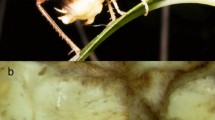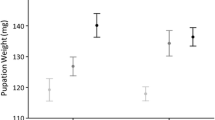Abstract
Theory predicts that selection acting across environments should erode genetic variation in reaction norms; i.e., selection should weaken genotype × environment interaction (G × E). In spite of this expectation, G × E is often detected in fitness-related traits. It thus appears that G × E is at least sometimes sustained under selection, a possibility that highlights the need for theory that can account for variation in the presence and strength of G × E. We tested the hypothesis that trait differences in developmental architecture contribute to variation in the expression of G × E. Specifically, we assessed the influence of canalization (robustness to genetic or environmental perturbations) and condition-dependence (association between trait expression and prior resource acquisition or vital cellular processes). We compared G × E across three trait types expected to differ in canalization and condition-dependence: mating signals, body size-related traits, and genitalia. Because genitalia are expected to show the least condition-dependence and the most canalization, they should express weaker G × E than the other trait types. Our study species was a member of the Enchenopa binotata species complex of treehoppers. We found significant G × E in most traits; G × E was strongest in signals and body traits, and weakest in genitalia. These results support the hypothesis that trait differences in developmental architecture (canalization and condition-dependence) contribute to variation in the expression of G × E. We discuss implications for the dynamics of sexual selection on different trait types.





Similar content being viewed by others
References
Al-Wathiqui N, Rodríguez RL (2011) Allometric slopes not underestimated by Ordinary Least Squares regression: a case study with Enchenopa treehoppers (Hemiptera: Membracidae). Ann Ent Soc Am 104:562–566
Andrade CAC, Vieira RD, Ananina G, Klaczko LB (2009) Evolution of the male genitalia: morphological variation of the aedeagi in a natural population of Drosophila mediopunctata. Genetica 135:13–23
Arnqvist G, Thornhill R (1998) Evolution of animal genitalia: patterns of phenotypic and genotypic variation and condition dependence of genital and non-genital morphology in water strider (Heteroptera: Gerridae: Insecta). Genet Res Camb 71:193–212
Bonduriansky R (2007) Sexual selection and allometry: a critical reappraisal of the evidence and ideas. Evolution 61:838–849
Borgia G (1979) Sexual selection and the evolution of mating systems. In: Blum MS, Blum NA (eds) Sexual selection and reproductive competition. Academic Press, NY, pp 19–80
Brakefield PM (2006) Evo-devo and contraints on selection. Trends Ecol Evol 21:362–368
Bussière LF, Hunt J, Stölting KN, Jennions MD, Brooks R (2008) Mate choice for genetic quality when environments vary: suggestions for empirical progress. Genetica 134:69–78
Cocroft RB, Rodríguez RL, Hunt RE (2008) Host shifts, the evolution of communication and speciation in the Enchenopa binotata complex of treehoppers. In: Tilmon K (ed) Specialization, speciation, and radiation: the evolutionary biology of herbivorous insects. University of California Press, Berkeley, pp 88–100
Cocroft RB, Rodríguez RL, Hunt RE (2010) Host shifts and signal divergence: mating signals covary with host use in a complex of specialized plant-feeding insects. Biol J Linn Soc 99:60–72
Cohen J (1988) Statistical power analysis for the behavioral sciences, 2nd edn. Lawrence Erlbaum Associates, New Jersey
Cotton S, Fowler K, Pomiankowski A (2004) Do sexual ornaments demonstrate heightened condition-dependent expression as predicted by the handicap hypotheses? Proc R Soc Lond B 271:771–783
de Visser JAGM, Hermisson J, Wagner GP, Meyers LA, Bagheri-Chaichian H, Blanchard JL, Chao L, Cheverud JM, Elena SF, Fontana W, Gibson G, Hansen TF, Krakauer D, Lewontin RC, Ofria C, Rice SH, von Dassow G, Wagner A, Whitlock MC (2003) Evolution and detection of genetic robustness. Evolution 57:1959–1972
Flatt T (2005) The evolutionary genetics of canalization. Q Rev Biol 80:287–316
Fry JD (1992) The mixed-model analysis of variance applied to quantitative genetics: biological meaning of the parameters. Evolution 46:540–550
Greenfield MD, Rodríguez RL (2004) Genotype–environment interaction and the reliability of mating signals. Anim Behav 68:1461–1468
Hamilton KGA, Cocroft RB (2009) Establishing the identity of existing names in the North American Enchenopa binotata species complex of treehoppers (Hemiptera: Membracidae). Entomol News 120:554–565
Hansen TF (2006) The evolution of genetic architecture. Annu Rev Ecol Evol Syst 37:123–157
Higgins SL, Hosken DJ, Wedell N (2009) Phenotypic and genetic variation in male genitalia in the seedbug, Lygaeus equestris (Heteroptera). Biol J Linn Soc 98:400–405
Hill GE (2011) Condition-dependent traits as signals of the functionality of vital cellular processes. Ecol Lett (in press)
Houle D (1992) Comparing evolvability and variability of quantitative traits. Genetics 130:195–204
House CM, Simmons LW (2007) No evidence for condition-dependent expression of male genitalia in the dung beetle Onthophagus taurus. J Evol Biol 20:1322–1332
Hunt J, Bussière L, Jennions MD, Brooks R (2004) What is genetic quality? Trends Ecol Evol 19:329–333
Ingleby FC, Hunt J, Hosken DJ (2010) The role of genotype-by-environment interactions in sexual selection. J Evol Biol 23:2031–2045
Kamimura Y, Iwase R (2010) Evolutionary genetics of genital size and lateral asymmetry in the earwig Euborellia plebeja (Dermpatera: Anisolabididae). Biol J Linn Soc 101:103–112
Kemp DJ, Rutowski RL (2007) Genetics, and the potential signal content of iridescent ultraviolet butterfly coloration. Evolution 61:168–183
Kokko H, Heubel K (2008) Condition-dependence, genotype-by-environment interactions and the lek paradox. Genetica 132:209–216
Lynch M, Walsh B (1998) Genetics and analysis of quantitative traits. Sinauer, Massachusetts
Miller LK, Brooks R (2005) The effects of genotype, age, and social environment on male ornamentation, mating behavior, and attractiveness. Evolution 59:2414–2425
Mills C, Alatalo RV, Koskela E, Mappes J, Oksanen TA (2007) Signal reliability compromised by genotype-by-environment interaction and potential mechanisms for its preservation. Evolution 61:1748–1757
Moran MD (2003) Arguments for rejecting the sequential Bonferroni in ecological studies. Oikos 100:403–405
Nakagawa S, Cuthill I (2007) Effect size, confidence interval and statistical significance: a practical guide for biologists. Biol. Revs 82:591–605
Ostrowski M-F, Jarne P, David P (2000) Quantitative genetics of sexual plasticity: the environmental threshold model and genotype-by-environment interaction for phallus development in the snail Bulinus truncatus. Evolution 54:1614–1625
Pratt G, Wood TK (1993) Genitalic analysis of males and females in the Enchenopa binotata (Say) complex (Membracidae: Homoptera). Proc Entomol Soc Wash 95:574–582
Radwan J (2008) Maintenance of genetic variation in sexual ornaments: a review of the mechanisms. Genetica 134:113–127
Rasband WS (1997–2009) ImageJ, U. S. National Institutes of Health, Bethesda. http://rsb.info.nih.gov/ij
Rodríguez RL, Sullivan LE, Cocroft RB (2004) Vibrational communication and reproductive isolation in the Enchenopa binotata species complex of treehoppers (Hemiptera: Membracidae). Evolution 58:571–578
Rodríguez RL, Ramaswamy K, Cocroft RB (2006) Evidence that female preferences have shaped male signal evolution in a clade of specialized plant-feeding insects. Proc R Soc B 273:2585–2593
Rodríguez RL, Sullivan LM, Snyder RL, Cocroft RB (2008) Host shifts and the beginning of signal divergence. Evolution 62:12–20
Roff DA (1997) Evolutionary quantitative genetics. Chapman & Hall, New York
Roff DA (2002) Life history evolution. Sinauer, Massachusetts
Rosenthal R (1991) Meta-analytic procedures for social research. Applied social research methods series, vol 6. Revised edition. SAGE Publications, Newbury Park
Rowe L, Houle D (1996) The lek paradox and the capture of genetic variance by condition dependent traits. Proc R Soc Lond B 263:1415–1421
Schulte-Hostedde AI, Zinner B, Millar JS, Hickling GJ (2005) Restitution of mass-size residuals: validating body condition indices. Ecology 86:155–163
Service PM, Rose MR (1985) Genetic covariation among life-history components: the effect of novel environments. Evolution 39:943–945
Sgrò CM, Hoffmann AA (2004) Genetic correlations, tradeoffs and environmental variation. Heredity 93:241–248
Stearns S, de Jong G, Newman B (1991) The effects of phenotypic plasticity on genetic correlations. Trends Ecol Evol 6:122–126
Steppan SJ, Phillips PC, Houle D (2002) Comparative quantitative genetics: evolution of the G matrix. Trends Ecol Evol 17:320–327
Stirling DG, Réale D, Roff D (2002) Selection, structure and the heritability of behaviour. J Evol Biol 15:277–289
Sullivan-Beckers L, Cocroft RB (2010) The importance of female choice, male–male competition, and signal transmission as causes of selection on male mating signals. Evolution 64:3158–3171
Tomkins JL, Radwan J, Kotiaho JS, Tregenza T (2004) Genic capture and resolving the lek paradox. Trends Ecol Evol 19:323–327
Via S, Conner J (1995) Evolution in heterogeneous environments: genetic variability within and across different grains in Tribolium castaneum. Heredity 74:80–90
Via S, Lande R (1985) Genotype–environment interaction and the evolution of phenotypic plasticity. Evolution 39:505–522
Via S, Lande R (1987) Evolution of genetic variability in a spatially heterogeneous environment: effects of genotype–environment interaction. Genet Res Camb 49:147–156
West-Eberhard MJ (2003) Developmental plasticity and evolution. Oxford University Press, NY
Wood TK (1993) Speciation of the Enchenopa binotata complex (Insecta: Homoptera: Membracidae). In: Lees DR, Edwards D (eds) Evolutionary patterns and processes. Academic Press, NY, pp 299–317
Zeng Z-B, Liu J, Stam LF, Kao C-H, Mercer JM, Laurie CC (2000) Genetic architecture of a morphological shape difference between two Drosophila species. Genetics 154:299–310
Acknowledgments
We thank Bill Eberhard, Kasey D. Fowler-Finn, Gerlinde Höbel, Michael Jennions, Darren Rebar, and three anonymous reviewers for discussion and helpful comments to previous versions of the manuscript. This work was funded by NSF Grant IOS-0919962 to RLR, and by UWM SURF awards to NA-W and RLR.
Author information
Authors and Affiliations
Corresponding author
Rights and permissions
About this article
Cite this article
Rodríguez, R.L., Al-Wathiqui, N. Genotype × environment interaction is weaker in genitalia than in mating signals and body traits in Enchenopa treehoppers (Hemiptera: Membracidae). Genetica 139, 871–884 (2011). https://doi.org/10.1007/s10709-011-9591-z
Received:
Accepted:
Published:
Issue Date:
DOI: https://doi.org/10.1007/s10709-011-9591-z




